Related Research Articles
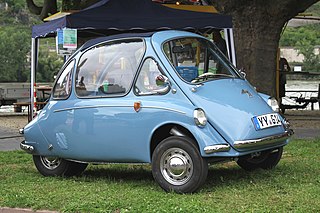
Microcar is a term often used for the smallest size of cars, with three or four wheels and often an engine smaller than 700 cc (43 cu in). Specific types of microcars include bubble cars, cycle cars, invacar, quadricycles and voiturettes, and the Japanese equivalent is the kei car.
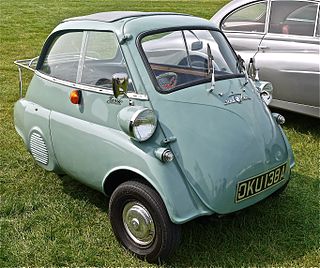
The Isetta is an Italian-designed microcar built under license in a number of different countries, including Argentina, Spain, Belgium, France, Brazil, Germany, and the United Kingdom. Because of its egg shape and bubble-like windows, it became known as a bubble car, a name also given to other similar vehicles.
Sharps Commercials Ltd was a British car maker based in Preston, Lancashire. It was founded in 1922 by Paul Sharp. It changed its name to Bond Cars Ltd in 1963. The company was taken over by the Reliant Motor Co Ltd of Tamworth, Staffordshire in February 1969, who eventually closed the Preston factory in August 1970, transferring the spare parts business for the Bond Minicar, 875 saloon, 875 Ranger van and Equipe models to a firm called Bob Joyner & Son in Oldbury in the English Midlands. Reliant nevertheless continued to use the Bond name until 1974 on Bond Bug models made at their own Tamworth plant.

Motobécane was a French manufacturer of bicycles, mopeds, motorcycles, and other small vehicles, established in 1923. "Motobécane" is a compound of "moto", short for motorcycle; "bécane" is slang for "bike."

The Messerschmitt KR200, or Kabinenroller, is a three-wheeled bubble car designed by the aircraft engineer Fritz Fend and produced in the factory of the German aircraft manufacturer Messerschmitt from 1955 until 1964.
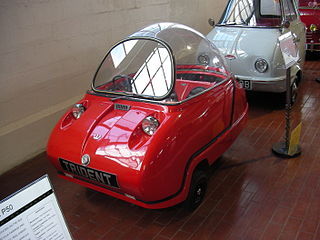
The Peel Trident is the second three-wheeled microcar made by the Peel Engineering Company on the Isle of Man. An all-new design from its one-seat counterpart the Peel P50, the Trident has two seats.
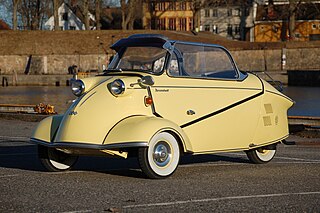
The Messerschmitt Kabinenroller was a series of microcars made by RSM Messerschmitt from 1953 to 1956 and by Fahrzeug- und Maschinenbau GmbH, Regensburg (FMR) from 1956 to 1964. All the Messerschmitt and FMR production cars used the Kabinenroller's monocoque structure, featuring tandem seating and usually a bubble canopy.

The Felber Autoroller T 400 was a three-wheeled microcar with a rear-mounted 398 cc Rotax two cylinder opposed twin, two stroke 15 metric horsepower (11 kW) engine. The cars had an unusual seating arrangement, with a small child-sized seat behind the driver on the left and a conventional passenger seat diagonally behind and to the right.

Goggomobil was a series of microcars produced by Hans Glas GmbH in the Bavarian town Dingolfing between 1955 and 1969.

The BMW 600 is a four-seater microcar produced by the German automaker BMW from mid-1957 until November 1959. Partially based on the BMW Isetta two-seater, it was BMW's first postwar four-seater economy car. It was not a sales success, but it began the design process for its more successful successor, the BMW 700.

S E Opperman was a tractor manufacturer in England. After he saw the Bond Minicar he decided to build his own four-wheel microcar at a factory in Elstree, Hertfordshire.
The Rodley was a British microcar designed by Henry Brown and built by the Rodley Automobile Company in Rodley, West Yorkshire between 1954 and 1956. Henry Brown also designed the Scootacar microcar.

Bond Minicar is a series of economical three-wheeled microcars which were manufactured by the British car manufacturer Sharp's Commercials Ltd, in Preston, Lancashire, between 1949 and 1966.

Arola SARL was a small manufacturing company based in Lyon-Corbas, France, which manufactured a range of microcars, designed to be driven without a license. Arola became part of the Aixam group in 1983.

Fuldamobil is the name of a series of small cars produced by Elektromaschinenbau Fulda GmbH of Fulda, Germany, and Nordwestdeutscher Fahrzeugbau (NWF) of Wilhelmshaven between 1950 and 1969. Various designated versions of the car were produced, although the vehicles produced under each designation were not always identical and the designations were sometimes misapplied. Though overall numbers produced were relatively small, the cars attracted sufficient attention to see licensed construction on four continents including Europe. In its ultimate configuration it is said to have inspired the term "bubble car". It is acknowledged as the first car in the world to feature a negative scrub radius, now recognised as a major advance in driving safety.

The AC Petite is a three-wheeled British microcar with a rear-mounted 350 cc (21 cu in) Villiers single cylinder, two-stroke engine. The car has a single bench seat seating two adults, and was said to be capable of 60 mpg‑imp to 70 mpg‑imp and 40 mph (64 km/h).
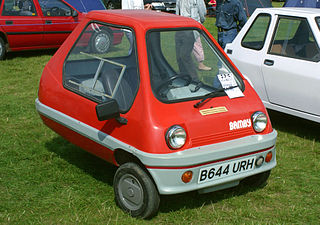
Bamby Cars was a British-built marque of microcars produced in small numbers in Hull, England, in the early 1980s. Bambys were designed and built by Alan Evans, who manufactured a one-off replica of the Peel P50 which also served as a prototype for further production.
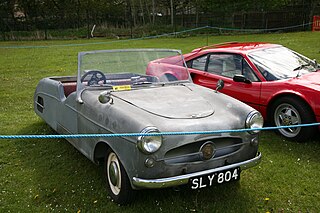
The Powerdrive was a three-wheeled microcar with a rear-mounted 322 cc (20 cu in) Anzani two cylinder, two stroke 16.5 metric horsepower (12 kW) engine.

The Alfa Romeo Tipo 103 is a sub-compact front-wheel drive automobile developed by Alfa Romeo in the late 1950s. A prototype powered by a 0.9 L double overhead cam inline-four engine was completed in 1960. Alfa did not put the Tipo 103 into production.

The Goliath F400 is a three-wheeled pickup transporter, made by Hansa-Lloyd and Goliath Company Borgward & Tecklenborg in Bremen, Germany which was sold under the brand Goliath. It was based on the three-wheeled passenger car Goliath Pionier with a closed timber-framed wood cab.
References
- ↑ Sedwick, Michael; Mark Gillies (1993). A-Z of Cars 1945-1970. Bay View Books. ISBN 1-870979-39-7.
- 1 2 Marshall, Tony (1999). Microcars. Sutton's Photographic History of Transport. Gloucester: Sutton Publishing Limited. ISBN 0-7509-2082-3.